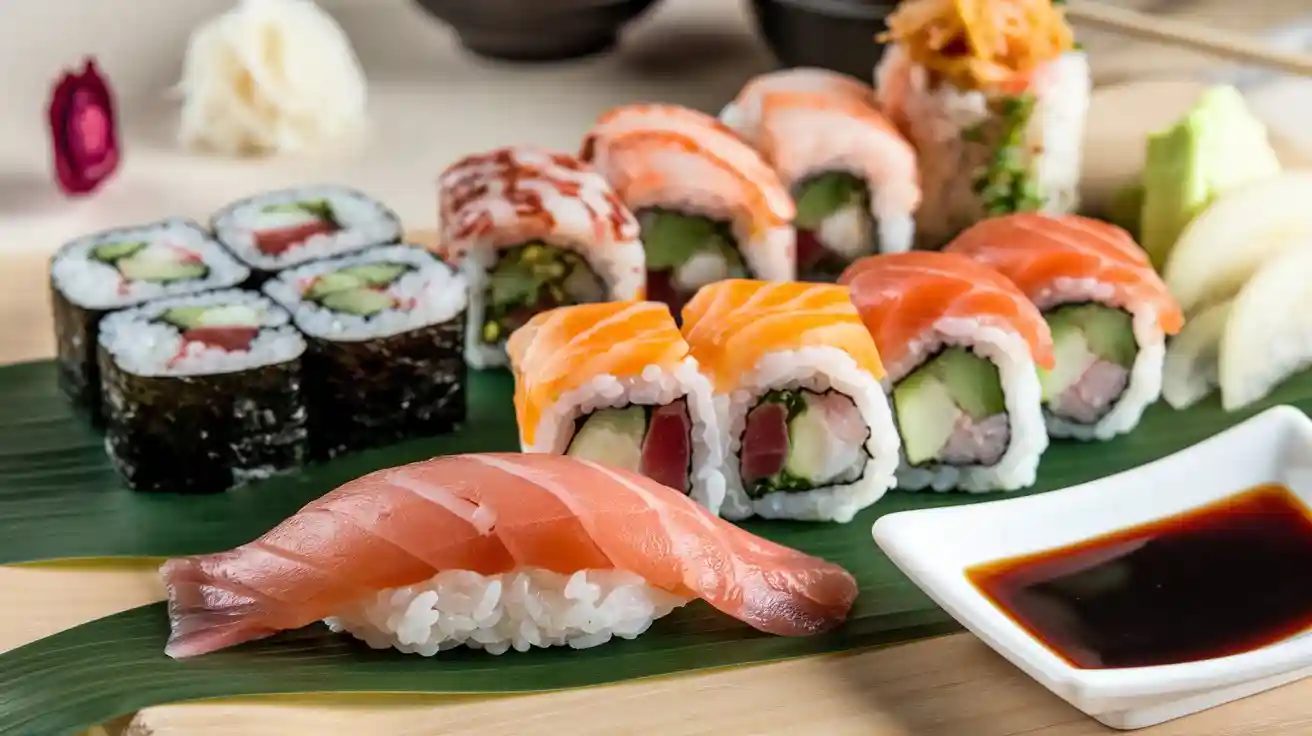Looking to enjoy sushi while maintaining a healthy diet? Low sodium sushi meal recipes offer the perfect solution for those who love sushi but want to reduce their sodium intake. With the right ingredients and simple modifications, you can create delicious sushi meals that are not only flavorful but also better for your health. Whether you’re aiming to lower your blood pressure or simply eat cleaner, these easy and nutritious recipes will help you enjoy sushi without compromising your wellness goals. Let’s dive into some simple, low sodium sushi meal ideas that you can prepare at home!
Table of Contents
Why Choose Low Sodium Sushi?

The Health Benefits of a Low Sodium Diet
A low sodium diet plays a vital role in promoting overall health and wellness. Reducing sodium intake is especially important for those looking to manage blood pressure, improve heart health, and maintain kidney function. Too much sodium in the diet can lead to high blood pressure, which increases the risk of heart disease and stroke. By opting for low sodium sushi meal recipes, you can enjoy all the flavors of sushi without the harmful effects of excessive sodium.
Incorporating low sodium meals into your diet can help reduce water retention and lower the risk of developing conditions like edema or kidney disease. Additionally, a low sodium intake can contribute to improved bone health, as excessive sodium can lead to the loss of calcium in bones over time. By choosing sushi recipes with fresh, natural ingredients like vegetables and low sodium soy sauce (or Tamari), you can enjoy a satisfying, flavorful meal while promoting better health.
So, next time you crave sushi, try out low sodium sushi meal recipes that not only taste great but also support your long-term health goals.
Common Sources of High Sodium in Sushi
While sushi can be a healthy and delicious option, certain ingredients commonly used in traditional sushi can be high in sodium. Here are some of the primary sources of high sodium in sushi:
- Soy Sauce
Regular soy sauce is one of the biggest culprits when it comes to sodium content in sushi. A single tablespoon of soy sauce can contain up to 1,000 milligrams of sodium, which is nearly half of the daily recommended intake. When added to sushi, it can significantly increase the overall sodium content. - Pickled Ginger (Gari)
Pickled ginger is often served alongside sushi to cleanse the palate, but it’s usually packed with sugar and sodium. The pickling process involves adding salt to preserve the ginger, making it a high-sodium ingredient. - Wasabi
While wasabi adds a flavorful kick to sushi, it can also contribute a surprising amount of sodium. Depending on the brand, wasabi paste can be made with high-sodium ingredients that enhance its flavor, adding extra salt to your meal. - Marinated Fish
Some types of sushi, especially those with fish like eel (unagi) or mackerel (saba), are often marinated in sauces that contain a significant amount of sodium. These sauces, which include sweet soy-based glazes, can raise the sodium content considerably. - Tempura and Fried Sushi
Tempura rolls and fried sushi tend to be high in sodium due to the batter and the oil used in the frying process. The seasonings and dipping sauces added to these dishes also contribute to the sodium load.
By being mindful of these high-sodium ingredients, you can modify your sushi to fit a lower sodium diet, such as by choosing low sodium soy sauce, avoiding pickled ginger, and opting for fresh or lightly seasoned fish.
Key Low Sodium Ingredients for Sushi
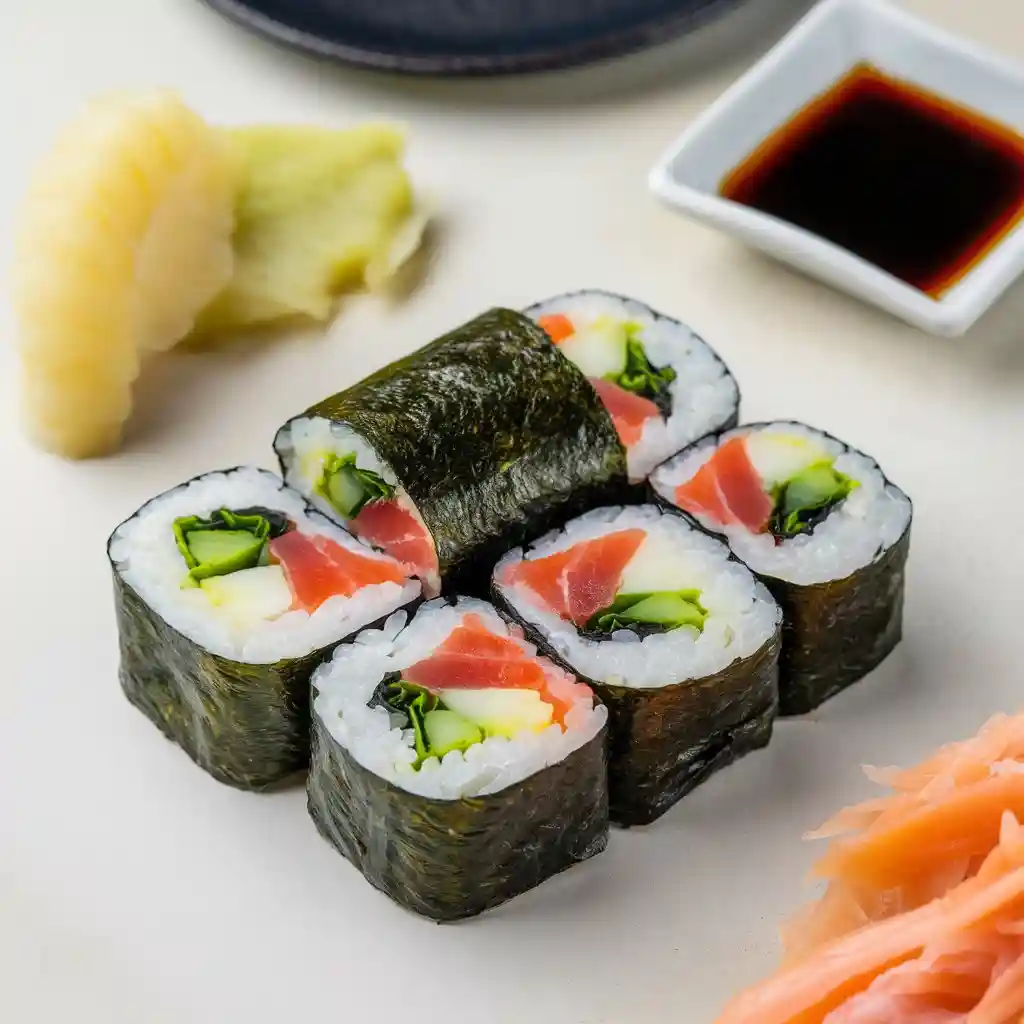
Rice Vinegar and Nori
When preparing low sodium sushi meal recipes, rice vinegar and nori are two key ingredients that can help you enjoy sushi without the added salt.
- Rice Vinegar
Rice vinegar is a common ingredient in sushi rice, adding a tangy, slightly sweet flavor without contributing much sodium. It’s a perfect choice for low sodium sushi meal recipes because it enhances the taste of the rice without increasing your sodium intake. Unlike traditional sushi rice seasonings, which may include salt or soy sauce, rice vinegar provides a more health-conscious alternative. - Nori (Seaweed)
Nori, the seaweed used to wrap sushi rolls, is naturally low in sodium and rich in essential minerals like iodine and calcium. It’s a great addition to low sodium sushi meal recipes, as it adds flavor and texture without significantly raising the sodium content. Nori is also a fantastic source of fiber and antioxidants, making it a healthy choice for your sushi rolls.
By using rice vinegar and nori in your sushi recipes, you can maintain the integrity and flavor of traditional sushi while keeping the sodium content low and your meal nutritious.
Low Sodium Fish Options
When creating low sodium sushi meal recipes, choosing the right type of fish is crucial for keeping your meal healthy and flavorful. Many fish varieties are naturally low in sodium, making them ideal for sushi rolls, sashimi, or bowls. Here are some of the best low sodium fish options to consider:
- Salmon
Salmon is a popular choice for sushi and is naturally low in sodium. It’s rich in healthy omega-3 fatty acids, which offer numerous health benefits, including improved heart health and reduced inflammation. Fresh, raw salmon is a great option for sushi, as it enhances flavor without adding excess sodium. - Tuna
Tuna, particularly the lighter varieties like albacore, is another low sodium fish commonly used in sushi. It has a firm texture and mild flavor, making it a versatile choice for rolls or sashimi. Tuna is also high in protein and low in fat, making it a healthy addition to any sushi meal. - Yellowtail
Yellowtail is a fatty fish that is rich in flavor yet low in sodium. It’s often served as sashimi or in sushi rolls and provides a delicate balance of taste and texture. Yellowtail is also packed with beneficial nutrients, including omega-3s and vitamin D. - Mackerel (Fresh, Not Marinated)
While marinated mackerel is often high in sodium, fresh mackerel can be a low sodium option for sushi. It’s a flavorful fish that works well when served as sashimi or in rolls. Be sure to avoid versions that are pickled or preserved in soy sauce to keep the sodium content low. - Halibut
Halibut is another low sodium fish that can be used in sushi. With a firm texture and subtle flavor, it can be served as sashimi or in rolls. Halibut is also a great source of lean protein, making it a healthy sushi option for those watching their sodium intake.
By selecting these low sodium fish options, you can enjoy delicious, nutritious low sodium sushi meal recipes without worrying about excessive sodium intake. Choose fresh, unseasoned fish to maintain the integrity of your meal and enhance the natural flavors of your sushi.
Vegetable-Based Fillings
Vegetable-based fillings are a great way to enjoy low sodium sushi meal recipes while adding flavor and nutrition. Vegetables are naturally low in sodium and offer a variety of textures and flavors. Here are some top choices:
- Cucumber
Crisp and refreshing, cucumber adds a mild flavor and is naturally low in sodium. It’s perfect for sushi rolls, hand rolls, or sushi bowls. - Avocado
Creamy and rich, avocado pairs well with other fresh ingredients and is high in healthy fats. It’s low in sodium and a great addition to sushi rolls. - Carrots
With their natural sweetness and vibrant color, carrots are low in sodium and high in vitamins. Thinly sliced or julienned, they add crunch to sushi. - Sweet Potato
Roasted or steamed sweet potato brings a sweet, earthy flavor to sushi rolls. It’s packed with vitamins and fiber while being low in sodium. - Spinach or Lettuce
Leafy greens like spinach and lettuce add freshness and crunch with very little sodium. They’re rich in vitamins and can be used in sushi rolls or bowls. - Bell Peppers
Sweet and crunchy, bell peppers add vibrant color and a juicy flavor to sushi rolls. They’re low in sodium and packed with vitamin C.
These vegetable-based fillings help reduce sodium while enhancing the flavor and nutrition of your low sodium sushi meal recipes.
5 Easy Low Sodium Sushi Recipes to Try
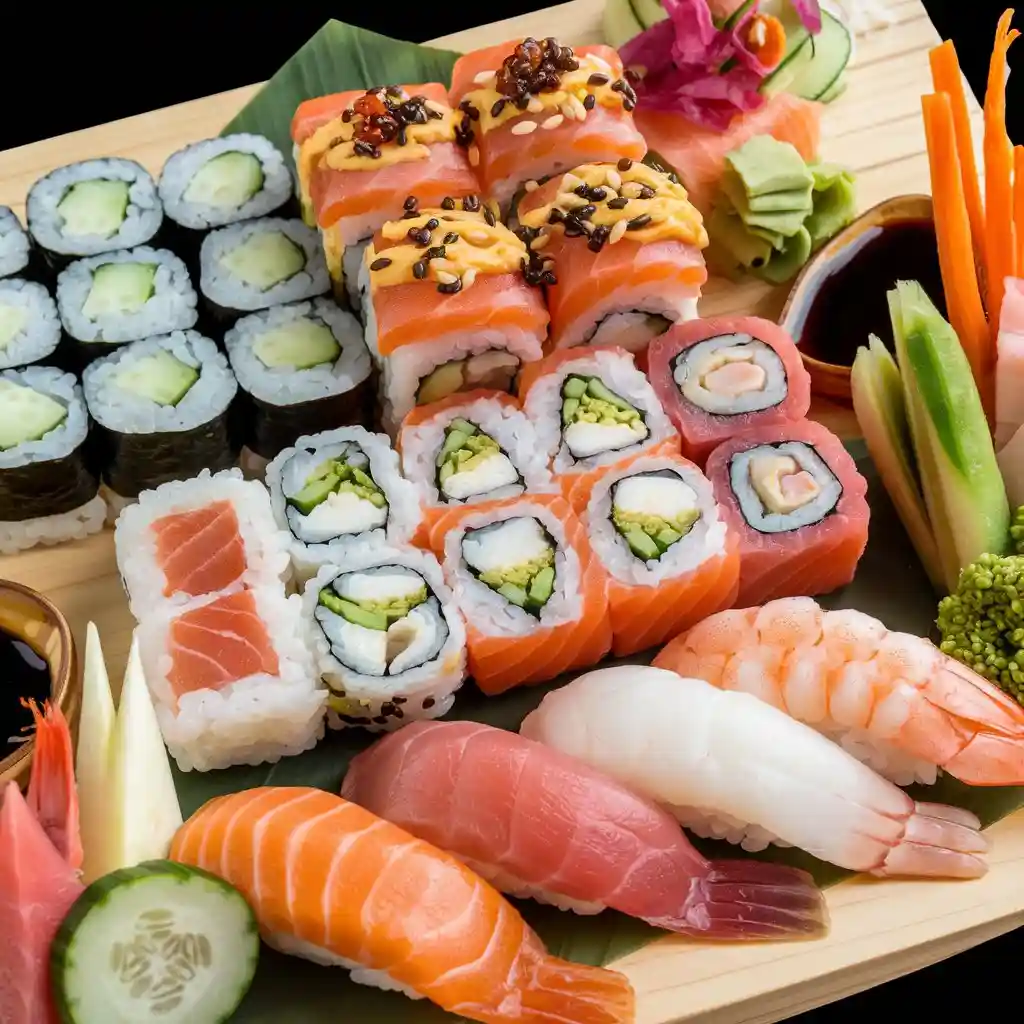
Recipe 1: Simple Cucumber and Avocado Rolls
This low sodium sushi meal recipe combines the freshness of cucumber and the creaminess of avocado for a simple yet delicious sushi roll. It’s perfect for a light meal and easy to prepare at home!
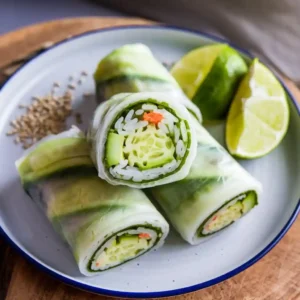
Simple Cucumber and Avocado Rolls
Ingredients
- 1 cup sushi rice cooked and seasoned with rice vinegar
- 1 sheet nori seaweed
- ¼ cucumber julienned
- ¼ avocado sliced
- A small bowl of low sodium soy sauce for dipping
- A bamboo sushi mat optional
Instructions
Prepare the Sushi Rice:
- Cook the sushi rice according to package instructions and season with rice vinegar. Let it cool to room temperature.
Prepare the Vegetables:
- Peel and julienne the cucumber. Slice the avocado into thin strips.
Assemble the Roll:
- Place a sheet of nori onto a bamboo sushi mat (or a clean surface). Spread an even layer of sushi rice over the nori, leaving about 1 inch at the top free of rice. Lay the cucumber and avocado slices in the center of the rice.
Roll the Sushi:
- Using the bamboo mat, gently roll the sushi from the bottom up, pressing lightly to keep it tight. Seal the edge with a little water.
Cut and Serve:
- Use a sharp knife to slice the roll into 6-8 pieces. Serve with low sodium soy sauce for dipping.
Notes
- Calories: 180
- Fat: 5g
- Protein: 4g
- Carbs: 32g
- Fiber: 4g
- Sodium: 25mg
Enjoy your Simple Cucumber and Avocado Rolls, a fresh and tasty way to enjoy sushi without the excess sodium!
Recipe 2: Tuna Sashimi with a Low Sodium Soy Sauce Dip
For sushi lovers who prefer a lighter, fish-focused dish, this low sodium sushi meal recipe features fresh tuna sashimi paired with a tangy low sodium soy sauce dip. It’s a simple, elegant dish that’s packed with protein and low in sodium.
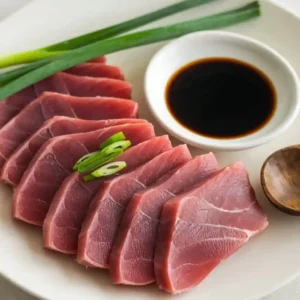
Tuna Sashimi with a Low Sodium Soy Sauce Dip
Ingredients
- 200 g fresh sushi-grade tuna
- 1-2 tbsp low sodium soy sauce
- 1 tsp rice vinegar
- 1 tsp sesame oil optional
- A pinch of sesame seeds optional
- Fresh wasabi or a small amount of grated horseradish optional
Instructions
Prepare the Tuna:
- Using a sharp knife, carefully slice the sushi-grade tuna into thin pieces, about 1/4 inch thick.
Make the Soy Sauce Dip:
- In a small bowl, mix together the low sodium soy sauce, rice vinegar, and sesame oil (if using). Stir well.
Serve the Sashimi:
- Arrange the tuna slices neatly on a plate. Sprinkle a pinch of sesame seeds on top for added flavor and texture if desired.
Enjoy:
- Serve the tuna sashimi with the low sodium soy sauce dip on the side. Add a small amount of fresh wasabi or grated horseradish for a bit of heat if you like.
Notes
- Calories: 180
- Fat: 3g
- Protein: 30g
- Carbs: 3g
- Fiber: 1g
- Sodium: 120mg (from tamari)
This Tuna Sashimi with a Low Sodium Soy Sauce Dip is a simple, yet flavorful way to enjoy sushi without the extra sodium!
Recipe 3: Salmon and Veggie Sushi Bowls
This low sodium sushi meal recipe features a healthy and vibrant bowl filled with fresh salmon, vegetables, and sushi rice. It’s a quick and customizable meal that brings all the flavors of sushi in a bowl, without the added sodium.
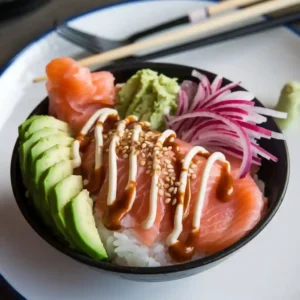
Salmon and Veggie Sushi Bowls
Ingredients
- 1 cup sushi rice cooked and seasoned with rice vinegar
- 100 g fresh sushi-grade salmon sliced
- ¼ avocado sliced
- ¼ cucumber julienned
- ¼ carrot julienned
- 1 tbsp low sodium soy sauce for drizzle
- 1 tsp sesame seeds optional
- Pickled ginger optional
Instructions
Prepare the Sushi Rice:
- Cook the sushi rice according to package instructions, then season with rice vinegar and let it cool slightly.
Prepare the Vegetables and Salmon:
- Slice the salmon into thin pieces. Julienne the cucumber and carrot, and slice the avocado.
Assemble the Sushi Bowl:
- In a bowl, add a base of sushi rice. Arrange the sliced salmon, avocado, cucumber, and carrot on top of the rice.
Garnish and Serve:
- Drizzle the low sodium soy sauce over the top. Sprinkle sesame seeds and add pickled ginger if desired.
Notes
- Calories: 350
- Fat: 18g
- Protein: 25g
- Carbs: 30g
- Fiber: 5g
Enjoy your Salmon and Veggie Sushi Bowls, a delicious and low sodium alternative to traditional sushi rolls!
Recipe 4: Maki Rolls with Low Sodium Soy Sauce
This low sodium sushi meal recipe is a simple take on traditional maki rolls, filled with fresh vegetables and a drizzle of low sodium soy sauce for flavor. It’s a fun and easy sushi option that’s perfect for lunch or dinner.

Maki Rolls with Low Sodium Soy Sauce
Ingredients
- 1 cup sushi rice cooked and seasoned with rice vinegar
- 1 sheet nori seaweed
- ¼ cucumber julienned
- ¼ avocado sliced
- ¼ carrot julienned
- 1 tbsp low sodium soy sauce for dipping
- Bamboo sushi mat optional
Instructions
Prepare the Sushi Rice:
- Cook the sushi rice according to package instructions and season with rice vinegar. Let it cool to room temperature.
Prepare the Vegetables:
- Julienne the cucumber and carrot, and slice the avocado into thin strips.
Assemble the Maki Roll:
- Place a sheet of nori onto a bamboo sushi mat (or a clean surface). Spread an even layer of sushi rice over the nori, leaving about 1 inch at the top free of rice. Lay the cucumber, avocado, and carrot in the center of the rice.
Roll the Sushi:
- Using the bamboo mat, carefully roll the sushi from the bottom up, pressing lightly to keep it tight. Seal the edge with a little water.
Slice and Serve:
- Using a sharp knife, slice the roll into 6-8 pieces. Serve with low sodium soy sauce for dipping.
Notes
- Calories: 250
- Fat: 12g
- Protein: 18g
- Carbs: 22g
- Fiber: 5g
- Sodium: 320mg (from low sodium soy sauce)
Enjoy your Maki Rolls with Low Sodium Soy Sauce, a healthy and satisfying way to enjoy sushi with minimal sodium!
Recipe 5: Veggie Temaki (Hand Rolls)
For a fun, hands-on sushi experience, these low sodium sushi meal recipes offer veggie-packed temaki (hand rolls). These easy-to-make rolls are filled with fresh vegetables and wrapped in seaweed for a crunchy, flavorful bite, perfect for anyone looking to reduce their sodium intake.
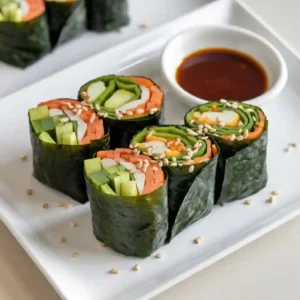
Veggie Temaki (Hand Rolls)
Ingredients
- 1 cup sushi rice cooked and seasoned with rice vinegar
- 1 sheet nori seaweed
- ¼ cucumber julienned
- ¼ avocado sliced
- ¼ carrot julienned
- ¼ bell pepper thinly sliced
- 1 tbsp low sodium soy sauce for dipping
- Pickled ginger optional
Instructions
Prepare the Sushi Rice:
- Cook the sushi rice according to package instructions and season with rice vinegar. Let it cool to room temperature.
Prepare the Vegetables:
- Julienne the cucumber and carrot, and slice the avocado and bell pepper.
Assemble the Hand Roll:
- Cut the nori sheet in half. Place a small amount of sushi rice in the center of the nori, leaving one edge free. Add the cucumber, avocado, carrot, and bell pepper on top of the rice.
Roll the Nori:
- Gently fold the nori into a cone shape, starting from the bottom and rolling it up tightly, securing the filling inside.
Serve:
- Serve the temaki immediately with low sodium soy sauce for dipping and pickled ginger if desired.
Notes
- Calories: 180
- Fat: 9g
- Protein: 3g
- Carbs: 27g
- Fiber: 5g
- Sodium: 150mg
These Veggie Temaki (Hand Rolls) are a quick, healthy, and fun way to enjoy sushi with a low sodium twist!
Tips for Making Sushi at Home
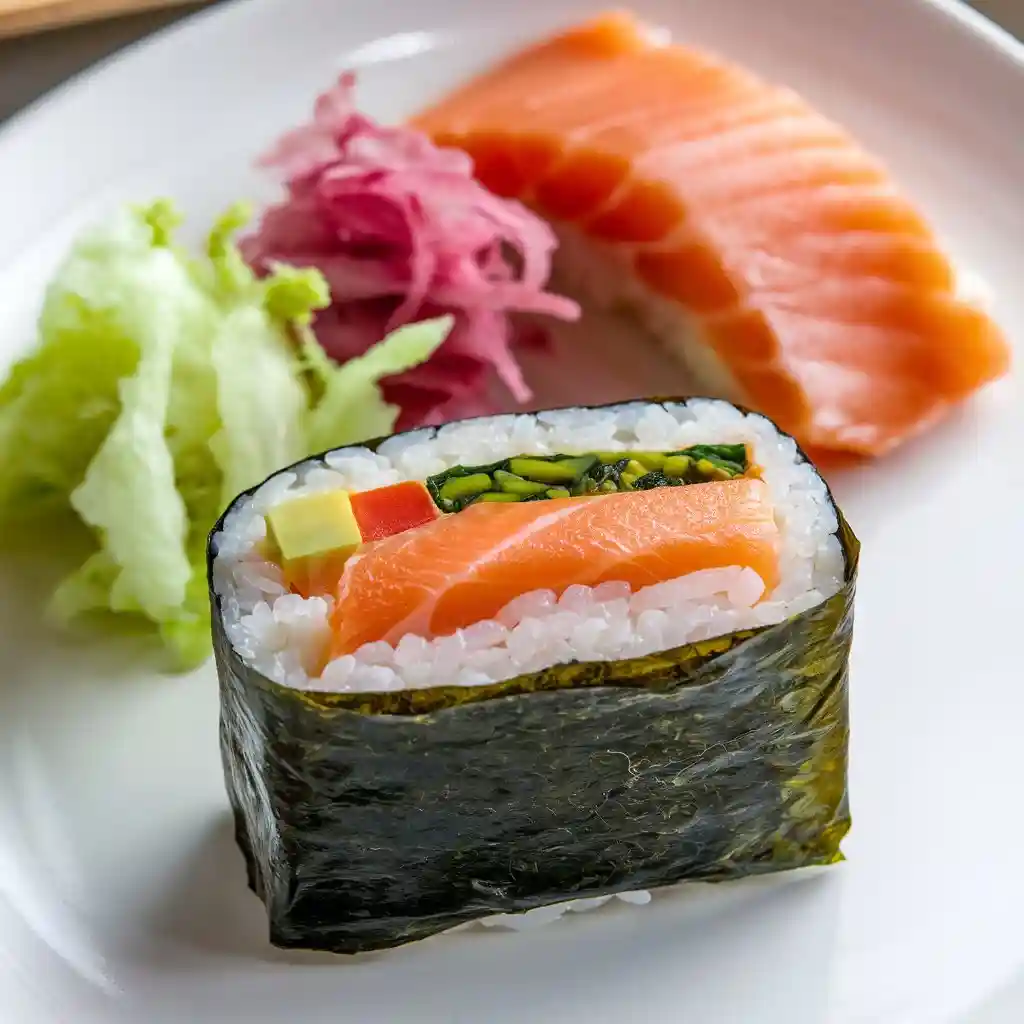
How to Prepare Sushi Rice
Preparing sushi rice is a key step in making low sodium sushi meal recipes. The rice needs to be seasoned correctly to achieve that perfect balance of flavor, while still keeping the sodium content low.
Ingredients:
- 1 cup sushi rice
- 1 1/4 cups water (for cooking)
- 2 tbsp rice vinegar
- 1 tbsp sugar (optional for sweetness)
- 1/2 tsp salt (optional for low sodium seasoning)
Instructions:
- Rinse the Rice
Place the sushi rice in a fine-mesh strainer and rinse it under cold water. Gently stir the rice with your hand to remove excess starch until the water runs clear. This step ensures that the rice will have the right texture once cooked. - Cook the Rice
Add the rinsed rice and 1 1/4 cups of water to a rice cooker or a pot. If using a pot, bring it to a boil, then reduce the heat to low and cover the pot. Let it cook for 18-20 minutes, or until all the water has been absorbed. Let the rice sit, covered, for another 10 minutes to steam. - Prepare the Seasoning
In a small saucepan, combine the rice vinegar, sugar (if using), and salt (optional). Warm the mixture over low heat, stirring occasionally until the sugar and salt have dissolved. Remove from heat and allow the seasoning mixture to cool. - Season the Rice
Transfer the cooked rice into a large bowl or a wooden sushi rice tub (hangiri). Gently pour the vinegar mixture over the rice and use a wooden spatula or rice paddle to fold the rice, ensuring that it’s evenly seasoned. Be careful not to mash or stir the rice too vigorously. - Cool the Rice
Let the seasoned rice cool to room temperature before using it in your sushi rolls or bowls. The rice should have a slightly sticky texture, making it easy to mold and hold its shape.
Now you have the perfect sushi rice for your low sodium sushi meal recipes! Enjoy it as a base for your sushi rolls, bowls, or hand rolls.
Using Low Sodium Alternatives in Traditional Sushi Ingredients
When preparing low sodium sushi meal recipes, swap out high-sodium ingredients for healthier alternatives:
- Soy Sauce:
- Traditional: Regular soy sauce is high in sodium.
- Low Sodium Alternative: Use low sodium soy sauce, which has 40% less sodium.
- Rice Vinegar:
- Traditional: Some rice vinegars contain added salt.
- Low Sodium Alternative: Choose rice vinegar without added salt for your sushi rice.
- Pickled Ginger:
- Traditional: Pickled ginger often contains added salt.
- Low Sodium Alternative: Make your own pickled ginger or buy low sodium versions.
- Wasabi:
- Traditional: Store-bought wasabi can be high in sodium.
- Low Sodium Alternative: Use fresh wasabi root or low sodium prepared versions.
- Fish:
- Traditional: Smoked or preserved fish can be high in sodium.
- Low Sodium Alternative: Use fresh, sushi-grade fish like tuna or salmon.
- Seaweed (Nori):
- Traditional: Some nori is seasoned with salt.
- Low Sodium Alternative: Choose unsalted, plain nori sheets.
These swaps will help you make delicious low sodium sushi meal recipes without compromising on flavor.
Making Sushi Rolls Without a Bamboo Mat
Making sushi rolls without a bamboo mat is easy and can be done with just a few simple tools. Here’s how you can make low sodium sushi meal recipes without the traditional bamboo mat:
Tools You’ll Need:
- A clean surface (cutting board or countertop)
- A sheet of plastic wrap (optional, for easier rolling)
- A sharp knife (for slicing the rolls)
Instructions:
- Prepare the Rice and Ingredients
Cook and season your sushi rice, then prepare your filling ingredients (like fresh fish, vegetables, or avocado). Lay them out on a clean surface. - Place the Nori
Lay a sheet of nori (seaweed) flat on your clean surface. If using plastic wrap, place the nori on top of it. - Spread the Rice
Wet your fingers to prevent the rice from sticking. Spread a thin, even layer of sushi rice over the nori, leaving about 1 inch at the top free of rice. - Add the Fillings
Arrange your fillings (such as cucumber, avocado, and fish) along the center of the rice. - Roll the Sushi
Carefully fold the bottom of the nori over the fillings, then continue rolling upwards, using your fingers to gently press the roll as you go. Once you reach the top, wet the edge of the nori with a little water to seal the roll. - Slice the Roll
Use a sharp knife to slice the roll into bite-sized pieces. Clean the knife between cuts for clean edges.
Enjoy your sushi rolls, made without a bamboo mat, with a low sodium soy sauce dip for extra flavor!
Final Thoughts on Low Sodium Sushi Meals

Enjoying Sushi as Part of a Balanced Diet
Sushi can be a great addition to a low sodium sushi meal recipe and a balanced diet when chosen and prepared thoughtfully. Here’s how you can enjoy sushi while ensuring it aligns with your healthy eating goals:
1. Focus on Fresh Ingredients
Choose fresh fish like tuna, salmon, or shrimp, which are packed with lean protein and healthy fats. Fresh vegetables like cucumber, avocado, and carrots provide essential vitamins, minerals, and fiber, making your sushi nutritious and filling.
2. Control the Portions
Sushi can be calorie-dense, especially with fried ingredients or sauces. Stick to moderate portions of sushi, such as rolls with a balance of vegetables and fish, and avoid excessive amounts of rice.
3. Choose Low Sodium Options
Opt for low sodium soy sauce and avoid pickled ginger or wasabi that are high in salt. By using low sodium alternatives, you can enjoy the full flavor of sushi without the added sodium.
4. Incorporate Variety
Including a mix of sushi types—such as sashimi, nigiri, and rolls with different vegetables and fish—adds variety to your diet. This ensures a wider range of nutrients and helps avoid over-reliance on one type of ingredient.
5. Pair with Healthy Sides
Consider pairing your sushi with side dishes like a miso soup made with low sodium broth or a seaweed salad. These options complement the sushi without adding excess calories or sodium.
By making mindful choices with your ingredients, portions, and seasoning, you can easily enjoy sushi as part of a balanced diet while keeping your sodium intake in check.
Encouraging Creativity with Sushi Ingredients
One of the joys of making sushi is the freedom to experiment with different flavors and ingredients. While traditional sushi uses specific ingredients, low sodium sushi meal recipes offer even more room for creativity without compromising on health. Here’s how you can get creative with your sushi:
1. Try Unique Fillings
While fish is a classic choice, there are plenty of other fillings to explore. Experiment with roasted vegetables like sweet potato, zucchini, or bell peppers. For a plant-based twist, try tofu, tempeh, or edamame.
2. Use Different Types of Rice
Instead of using traditional sushi rice, consider alternatives like brown rice, quinoa, or cauliflower rice. These options can add a unique texture and more nutritional benefits to your sushi rolls.
3. Get Creative with Nori Alternatives
While nori (seaweed) is the traditional wrap, you can switch it up by using large lettuce leaves, rice paper, or even cucumber slices as a fresh, crunchy wrap.
4. Play with Sauces and Seasonings
Get creative with your sushi seasoning! Use low sodium soy sauce or try alternatives like coconut aminos. You can also add a drizzle of sesame oil, sriracha (for a little heat), or a sprinkle of toasted sesame seeds for extra flavor.
5. Incorporate Fruits
Fruits like mango, pineapple, or even berries can add a sweet twist to your sushi rolls. They pair wonderfully with fish or can be combined with vegetables for a refreshing, light roll.
6. Experiment with Sushi Shapes
While rolls and nigiri are the most common shapes, why not try hand rolls (temaki) or sushi bowls? These allow for more flexibility with ingredient combinations and are a fun way to serve sushi.
By encouraging creativity with your sushi ingredients, you can make delicious and healthy low sodium sushi meal recipes that are tailored to your tastes and dietary preferences!
The Long-Term Benefits of Reducing Sodium in Your Diet
Reducing sodium in your diet, such as through low sodium sushi meal recipes, can have a significant positive impact on your health over time. Here are some of the long-term benefits of cutting back on sodium:
1. Better Heart Health
High sodium intake is linked to high blood pressure, a major risk factor for heart disease and stroke. By reducing sodium, you can help keep your blood pressure in check, which reduces the risk of cardiovascular issues and promotes overall heart health.
2. Reduced Risk of Stroke
Lower sodium consumption can help lower your blood pressure, which in turn reduces the likelihood of having a stroke. Over time, a low-sodium diet can contribute to long-term brain health and prevent damage from high blood pressure.
3. Improved Kidney Function
Excess sodium can strain your kidneys by increasing the amount of water your kidneys must filter. Reducing sodium helps to lessen this burden, improving kidney function and lowering the risk of kidney disease in the long run.
4. Better Bone Health
Consuming too much sodium can cause calcium loss through urine, weakening your bones over time. By reducing your sodium intake, you can help protect your bones and reduce the risk of osteoporosis later in life.
5. Weight Management
Sodium causes your body to retain water, which can lead to bloating and weight gain. By reducing sodium, you can help control water retention, leading to a healthier, more balanced weight over time.
6. Improved Digestive Health
Excess sodium can irritate the stomach lining, leading to digestive discomfort and bloating. A low sodium diet supports better digestive health, allowing your body to process food more efficiently and reducing discomfort.
By consistently lowering sodium in your diet, including through low sodium sushi meal recipes, you can enjoy long-term health benefits, including better heart health, kidney function, and overall well-being.
FAQs About Low Sodium Sushi Meal Recipes
What is low sodium sushi?
Low sodium sushi refers to sushi that is prepared using ingredients with reduced sodium content, such as low sodium soy sauce, fresh fish, and unsalted nori, to promote a healthier diet.
Can I make sushi without a bamboo mat?
Yes, you can make sushi without a bamboo mat by using a clean surface, plastic wrap, or just your hands to roll the sushi tightly.
How can I reduce sodium in sushi?
To reduce sodium in sushi, use low sodium soy sauce, avoid pickled ginger and wasabi with added salt, choose fresh, non-preserved fish, and opt for unsalted nori and rice vinegar.
Is sushi healthy?
Sushi can be healthy when made with fresh ingredients like fish, vegetables, and whole grains. By opting for low sodium ingredients, you can make sushi even healthier.
What are some low sodium fish options for sushi?
Fresh fish like tuna, salmon, and shrimp are excellent low sodium options for sushi, providing lean protein and omega-3 fatty acids without excessive sodium.
How do I make sushi rice?
To make sushi rice, cook short-grain rice, then season it with a mixture of rice vinegar, sugar, and salt (or a salt substitute) to create a flavorful base for your rolls.
Can I make sushi with vegetables instead of fish?
Yes, you can make delicious vegetable sushi by using fillings like cucumber, avocado, bell pepper, and sweet potato, offering a plant-based, low sodium alternative.
What is the benefit of reducing sodium in sushi?
Reducing sodium in sushi helps lower the risk of high blood pressure, heart disease, and stroke while promoting overall health and well-being.
Are there any low sodium alternatives for soy sauce?
Yes, you can use low sodium soy sauce or coconut aminos as a healthier alternative to traditional soy sauce, both containing less sodium.
Can I store sushi for later?
Sushi is best enjoyed fresh but can be stored in the refrigerator for a few hours. It is not recommended to store sushi for extended periods, as it may lose its texture and flavor.
Incorporating low sodium sushi meal recipes into your diet is a delicious and healthy way to enjoy sushi while reducing your sodium intake. By choosing fresh ingredients, using low sodium alternatives, and getting creative with your fillings, you can create flavorful sushi that supports your long-term health goals. Enjoying sushi in moderation and with mindful ingredient choices will help you maintain a balanced diet and enhance your overall well-being.
If you love crispy, flavorful dishes, try our Air Fryer Lectin-Free Fish and Chips. This healthier take on the classic combines perfectly seasoned fish with crispy, golden fries, all cooked to perfection in the air fryer. With no lectins, it’s a delicious and satisfying meal that’s perfect for any occasion.
For more sushi inspiration, check out Sushi Ideas. Explore a variety of creative and flavorful sushi recipes that will delight your taste buds and satisfy your cravings, perfect for any occasion or gathering.
More Healthy Recipes To Try:

